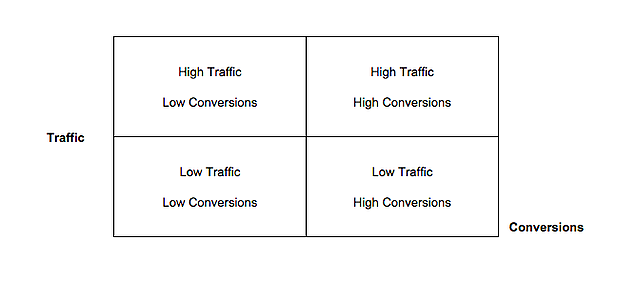The Building Blocks of a Conversion Rate Optimization Framework

Website conversion rate optimization is all the buzz these days with companies such as KissMetrics, Unbounce, and Optimizely releasing an enormous amount of great content on the subject (and offering great platforms to execute it on). However in many conversations I've had, it seems like one question continues to come up: "This sounds great and I want to get going, but where do I start?"
With that in mind, here's a simple CRO framework that we like to use to help prioritize your conversion rate optimization efforts.
A conversion rate optimization framework is simpler than it sounds
 Now before we dive in, let's take a step back and identify a couple steps that you need to take before you set up your first tests.
Now before we dive in, let's take a step back and identify a couple steps that you need to take before you set up your first tests.
- Begin with a foundation of analytics and define reporting requirements, the tools (platform) needed, and the personnel structure required to undertake a CRO effort successfully.
- Identify the key benchmarks for existing performance (visit-to-lead conversion rate, bounce rate, time on site, etc.) that you'll be measuring and form a clear and measurable hypothesis on how these can be improved.
- Set clear goals on what you're hoping to achieve.
Now back to the framework. Let's get started! Think of our quadrants as a Cartesian system and begin with Quadrant I:
High Traffic and High Conversions:
These are your top-performing pages and can be prioritized last for optimization testing.
However, they've been the cornerstone of our lead gen efforts for months. Start by assessing these pages and understanding why they do well. Are they featured prominently in your navigation and driving lots of direct traffic? Are they SEO optimized and ranking well for a high-volume search term? Are the CTAs on this page clearer than those on the rest of your site? Is the content so compelling that someone couldn't possibly not convert?
With this in mind, determine how these elements can be carried over to pages that aren't performing as well.
High Traffic and Low Conversions:
These should be the first pages you begin to test and prioritize.
- A pair of eyes looking at a CTA will help improve the click-through rate.
- Action at the top of the page is taken more than one at the bottom of the page.
- Limit CTAs on the page (ideally limited to one per page).
- Evaluate content.
Low Traffic and Low Conversions:
This is the toughest segment of the lot. Not only are they not driving conversions, they're also not getting as much traffic. This means it's going to take more time for those pages to reach a statistically significant volume of conversions to reach conclusions on any test.
- Figure out how to drive more traffic.
- Incorporate what you've learned in your other tests.
Low Traffic and High Conversions:
These should be your second priority after you've got tests up and running on your high traffic, low conversion pages.
- Drive more quality traffic.
- Start with optimization via paid and organic search.
- Improve navigation to drive more traffic.
Now that your tests are up and running, continue to measure and optimize over time. Remember, no website is ever perfect.





